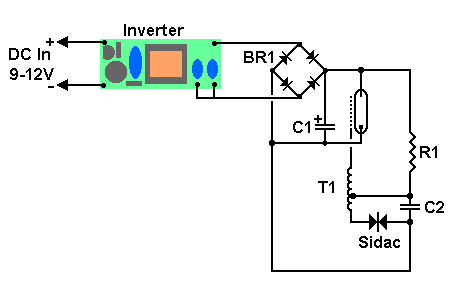
This strobe runs from 9 to 12 volts DC nominally, but has worked as low as 4 volts and as high as 14 volts with no problems known yet except for low power or low flash rate at lower voltages. The inverter is a JKL Lamps model intended for miniature cold cathode fluorescent lamps, available from All Electronics, (800)826-5432 or (818)904-0524. The catalog number is BXA-12529 and the price according to their number 500 Summer/Fall 2000 catalog is $9.95. Digi-Key, (800)DIGIKEY also sells these inverters.
Strobes using this or other CCFL inverter boards can be compact and light enough to use in some model rockets. Note that the sidac based trigger circuit results in a flash rate that is not regulated but slows down if battery voltage weakens during use.
Now for the circuit:
BR1 consists of high speed rectifier diodes of voltage well over what the energy storage capacitor C1 would charge up to. If uncertain, use 800 volt or 1KV diodes. Ordinary rectifier diodes are usually too slow to work well with high frequency inverters so you need fast diodes. I used Digi-Key catalog number HER105CT. Since those are 400 volt diodes, I had to put two in series for each of the four "diodes" in the bridge rectifier.
T1 is a trigger transformer. If you have any 4-terminal ones as opposed to a 3 terminal one, connect the "low" end of the secondary to one of the primary leads. For more info on trigger transformer usage and even construction, go to my Trigger Coil Page.
C1 is the energy storage capacitor. You could use a photoflash capacitor for a slow, bright strobe. Or you could use the 10 microfarad 400 volt Hosfelt Electronics 15-976 for a moderate speed strobe (1-2 flashes per second) or the 1 microfarad 1 KV Hosfelt 15-941 for faster strobes. I consider these capacitors particularly good for strobes among lower value capacitors. Lower value capacitors should have "extended foil design" or be rated for use in pulse forming networks, although axial lead electrolytics 10-40 uF are probably at least fairly good.
FLASHTUBE - Any small strobe or small camera or small photoflash tube should work. I used the Electronic Goldmine G8178 small flashtube/reflector combo. In the ones I got, the anode wire (+) is orange, the cathode wire is green, and the trigger connection is a small tab on the rear of the assembly near the center. I have also used flashtubes from disposable cameras.
C2 is the trigger capacitor and R1 is the trigger resistor. So far I have been using 1 meg and .047 microfarads for faster strobes using 1 uF for the main energy storage capacitor. For slower strobes, I increased C2 to .1 uF. The larger C2 seemed necessary to trigger the flashtube when the C1 voltage was less. Another option to slow the flash rate, not yet tested, is a higher value for R1 such as 2.2 meg.
Note that C2 must be a decent type capable of withstanding the current surge that occurs when it discharges into the trigger transformer. I have seen Radio Shack capacitors fail from this. Ones that are reliable include the Panasonic ECQ-M series or "M series". 400 volt ones of .047, .056, .068, .082 and .1 uF are available from Digi-Key with catalog numbers of P1078, P1079, P1080, P1081 and P1082 respectively. Or you could hack the capacitor from a cheap camera flash - but you may have to put two in parallel if they are too low in value.
The sidac I used was a series pair of Teccor K1300E70 130 volt units to create a 260 volt pair. These are available from Digi-Key using K1300E70 as the catalog number.
Back Up 2 Levels to Don's Xenon Top Page.
Back Up 3 Levels to Don's Home Page.
Written by Don Klipstein.
Please read my Copyright and authorship info.
Please read my Disclaimer.